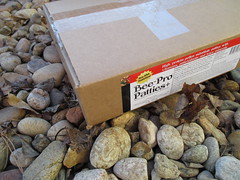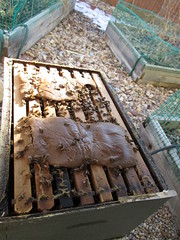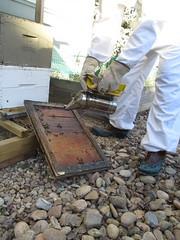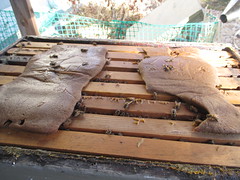It was warm today, nearly 60, and the side yard was sunny and bright. When I went out at 2pm I heard the hum that Jet calls 'the vacuum sound'. It's the usual sound of new bees orienting themselves!
After the other article about the fact that the bees are still rearing young in the winter, it wasn't as unexpected as it would have been before. But I was still pleasantly surprised to see the cloud of bees hovering in front of the hive. It made me put on my suit and veil and have John light up my smoker, because I was going to approach a living, active hive instead of the one that was very quiet and didn't have that many bees in December.
This is the box of patties that I was mailed. It's probably more than a single hive can use in a winter, given how slowly they're actually eating it. It's about 10 pounds of pollen substitute, sugar, and corn syrup cooked into slabs that can fit under the lid of the hive. The mix of proteins smells like brewer's yeast when I open up the bag, and it's supposed to be refrigerated, so I keep it in our 30 degree garage on the most part. When the weather warms and I start putting supers onto the boxes I can't have this stuff on the bars because the bees will try to pack some of it away.
So it'll probably go into the freezer at that point, and there's plenty for at least another year, even if I split the hive into two hives and have two in the spring. We'll see how it works out.
It's interesting thinking about what a bee probiotic really is, *laughs* I do love the advertising, though.
Here's what we saw when I pulled the top off the boxes. There's a lot more bees than there were in December. I was pretty impressed at how many were on the patties themselves and getting chunks off of it to feed on. There's a huge chunk out of the front patty and they're both pretty nibbled.
So I figured that they were definitely using the things. The only problem was that I couldn't move the original remains, as they were too soft from the warmth of the day! So I had to cut a new patty into strips to try and fit it into the spaces between.
I am glad that they're using them, so it means that they really needed the extras. The bees do keep a little pollen in what they call beebread, and they stuff some cells with the stuff, but here there's no flowers through the winter, so pollen's hard to come by. Therefore, these patties are supplementing the food needed to raise larvae.
When I raised the lid in December none of the bees were on the lid, and nearly none of them were in the upper chamber of the two boxes. So seeing this many bees on the lid was very cool. They were active, buzzing, and two or three were coming at me to defend the hive. The rest were just busy going about their business in the box and on the lid.
There were just a few bees using the front entrance at this point. The others had already oriented, and were gone back inside. The sun had gone to the west enough to leave the hive in shadow, so it was getting gradually chillier.
I had some problems putting the new patty on until I realized that the inner lid actually had a lip of about an inch and a half, not just the width of the rim of the boxes. I had to pull the new stuff back far enough so that the lid could go back on. It was pretty clear, though, that the bees were doing well, and that their numbers have already increased.
There were about a dozen bodies out the front entrance, and one lady was dead on the front edge of the landing board. That was interesting to see, she looked as if she were about to take off, but was so utterly still.
Here's a clearer look of the two eaten away patties. There's holes in the one to the left and the one on the right is carved away quite neatly. There's poke marks everywhere, so they're definitely taking away from them both. The new patty that I put half of on here was all shiny and smooth.
The girls were all pretty active, so I have good hopes for the coming year. It's definitely not looking like they're going to die out this winter, even if it gets cold again. After they survived two cold spells, they're now increasing their numbers, so it's looking good. The more of them there are, the more area they'll be able to incubate, and the more they'll increase. I just hope that I manage to figure out if I should split the hive in March before they decide to swarm.
Friday, January 17, 2014
Tuesday, January 14, 2014
What I Didn't Know About Winter Bees
Donald Studinski is one of the more outspoken beekeepers in the Colorado beekeeping associations. He's knowledgable, experienced, and very very opinionated about how he sees the world of beekeeping. I often enjoy his missives, and recently he came up with a really nice article about what really happens with bees during the winter: Deep Freeze, Honeybees, and You. The title is kind of funny, but it has some really intriguing details about what bees really do all winter and how they actually are raising young through the cold months.
We had a good eight inches of snow during the cold blast that froze most of the rest of the country, and in the following days it started to all melt and slide off the roof.
When I had the beehive on the window-wells of the basement, it was out of the arc of the fall of snow from the 2nd story roof on that side of the house (also the solar panels are up there, which is another story all together); but now that I moved it off the window wells, the hive is right in the path of the falling snow. So I had John put the cover up. It's just a huge sheet of particle board that's screwed to a couple of supporting posts.
The problem was that the bottom edge of the particle board, once the board was covered in snow, was right where the run off from the warping board fell onto the entrance of the hive!! Half a dozen of the girls drowned trying to get out of the hive while the melt was happening. Agh. When I discovered this, John and I went out, pulled the hive back the few inches it needed to keep the entrance out from under that edge, and I propped the back of the hive up a couple of inches (the width of a 2x4). Water ran out the front. Gah.
But it all dried within six hours of that, and the next day I saw dozens of the girls flying again. They'd dragged the bodies out of the hive. I saw one of the girls bodily picking up a carcass and flying away with it. About half a dozen are dumped just below the entrance, but most have been tidily cleaned up and taken away. So they're doing quite well, it seems, and I am supposed to have a 60 degree day in the next few days. I should be able to go in and see if they're eating the patties and using the proteins for their winter brood. I'll definitely take pictures then.
We had a good eight inches of snow during the cold blast that froze most of the rest of the country, and in the following days it started to all melt and slide off the roof.
When I had the beehive on the window-wells of the basement, it was out of the arc of the fall of snow from the 2nd story roof on that side of the house (also the solar panels are up there, which is another story all together); but now that I moved it off the window wells, the hive is right in the path of the falling snow. So I had John put the cover up. It's just a huge sheet of particle board that's screwed to a couple of supporting posts.
The problem was that the bottom edge of the particle board, once the board was covered in snow, was right where the run off from the warping board fell onto the entrance of the hive!! Half a dozen of the girls drowned trying to get out of the hive while the melt was happening. Agh. When I discovered this, John and I went out, pulled the hive back the few inches it needed to keep the entrance out from under that edge, and I propped the back of the hive up a couple of inches (the width of a 2x4). Water ran out the front. Gah.
But it all dried within six hours of that, and the next day I saw dozens of the girls flying again. They'd dragged the bodies out of the hive. I saw one of the girls bodily picking up a carcass and flying away with it. About half a dozen are dumped just below the entrance, but most have been tidily cleaned up and taken away. So they're doing quite well, it seems, and I am supposed to have a 60 degree day in the next few days. I should be able to go in and see if they're eating the patties and using the proteins for their winter brood. I'll definitely take pictures then.
Subscribe to:
Posts (Atom)



